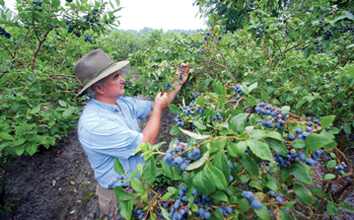Though the branding initiative was designed to promote New Jersey produce to the state’s residents, the scope has widened considerably, according to Nardelli, whose company was a founding member of the program. “Now, the awareness of Eastern-grown fruits and vegetables is really developing. Western-grown commodities used to control the market due to their size, but we’ve developed a nice niche.”
By the Numbers
New Jersey’s abundance is dished up by eight principal fruit and vegetable-producing counties: Atlantic, Burlington, Camden, Cape May, Cumberland, Gloucester, Salem, and southern Ocean.Topping the menu are blueberries, cranberries, bell peppers, spinach, and peaches with a combined value of nearly $200 million annually. The Garden State’s basket is also dominated by vegetables destined for fresh market, with almost 84 percent (or 42,000 of 50,000 acres) of land planted for potatoes, melons, and other vegetables harvested for fresh use, as reported in the most recent census of agriculture.
Here are some facts and figures related to the Garden State’s fresh produce:
• Though ranked third nationally for cranberry production, New Jersey had the second-highest yield (nearly 209 barrels per acre) and commanded the highest price ($35 per barrel) in 2014
• The value of New Jersey’s utilized apple production has risen from under $13.8 million in 2005 to $29.8 million in 2014
• Total value for the state’s blueberry production in 2014 was up 40% from 2013, with the average fresh market price up 22¢ per pound
• Harvested blueberry acreage has climbed from 150 acres in 1929 to 1,500 acres in 1943 to 8,800 acres in 2014.Sources: New Jersey Department of Agriculture, USDA National Statistics Service.
The exposure has certainly helped another Cedarville-based company, the aptly named Eastern Fresh Growers. President Thomas Sheppard points out that the state’s locally grown fruits and vegetables are not only fresher due to short delivery distances, but also better for the environment. “Produce shipped in from the West Coast leaves a bigger carbon footprint.” Though there is some controversy within the state about the definition of ‘local,’ the program’s impact has been considerable.
Ups and Downs: Weather and Food Safety
Despite the advantages, the industry is not all a bowl full of blueberries. The cold, snowy winter delayed early spring work and plantings. “We like to have the asparagus mowed, with fertilizer and weed killer down by the close of March,” offers Sheppard, but this was not possible this spring, as “the fields were just too wet.”



